
White Flowering Shrubs: Mock Orange
Philadelphus spp., Zones 3 to 11
These easygoing white flowering shrubs can be grown in a range of soils and amounts of light—just avoid soggy, poorly draining patches. Pick a cultivar with flower buds that are hardy in your region. Many cultivars are smaller, but some reach up to 10 feet tall and 5 feet wide. Try Illuminati Tower for spires of yellow-centered white blooms.
Why we love it: Plant this beauty near windows or anywhere you often pass to get a whiff of the richly scented flowers that bloom in spring.
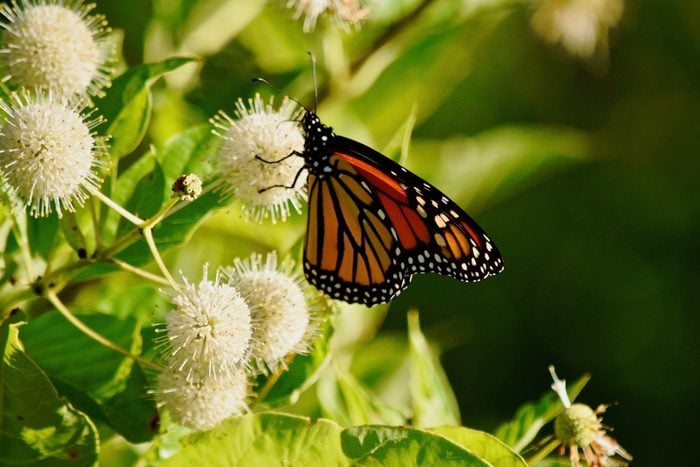
Buttonbush
Cephalanthus occidentalis, Zones 3 to 11
Watch bees, butterflies and hummingbirds flock to these fragrant, spherical white flowering shrubs. Buttonbush is also a host plant for several types of caterpillars. The round fruit persists through winter, providing food for a variety of birds. Grow it in full to partial sun and moist soil. It grows more than 6 feet tall and wide.
Why we love it: This long-flowering plant provides months and months of enjoyment.
Also consider these pretty yellow flowering shrubs for your yard.

Smooth Hydrangea
Hydrangea arborescens, Zones 3 to 8
A carefree shrub that reaches 4 to 5 feet tall, in summer it boasts large mophead flower clusters. Long-lasting blooms look lovely even as they fade and also make good cut flowers.
Why we love it: Large white blooms gradually fade to green.
Discover more breathtaking hydrangea species.
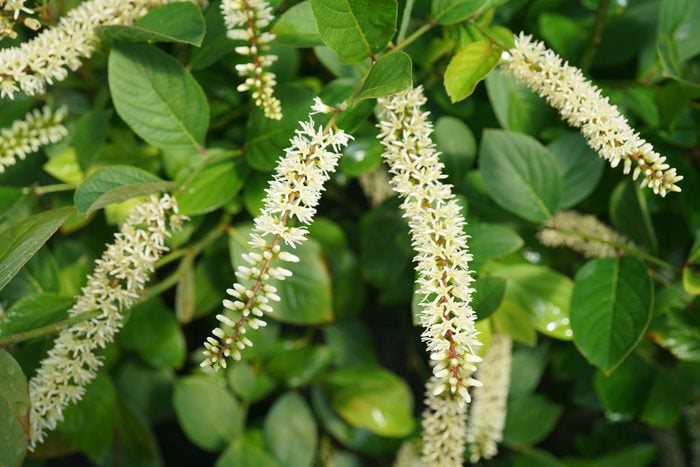
Virginia Sweetspire
Itea virginica, Zones 5 to 9
The Virginia sweetspire’s white flowers, which give off a slight fragrance, attract hummingbirds, bees and butterflies. Plant it in sun or shade and moist, acidic soils. Sweetspire grows 3 to 6 feet tall and wide. Select Henry’s Garnet for exceptional flowering or the smaller Little Henry for tight spaces.
Why we love it: The leaves change from green to yellow, orange and reddish purple colors during fall.
Check out the top 10 small shrubs for small spaces.
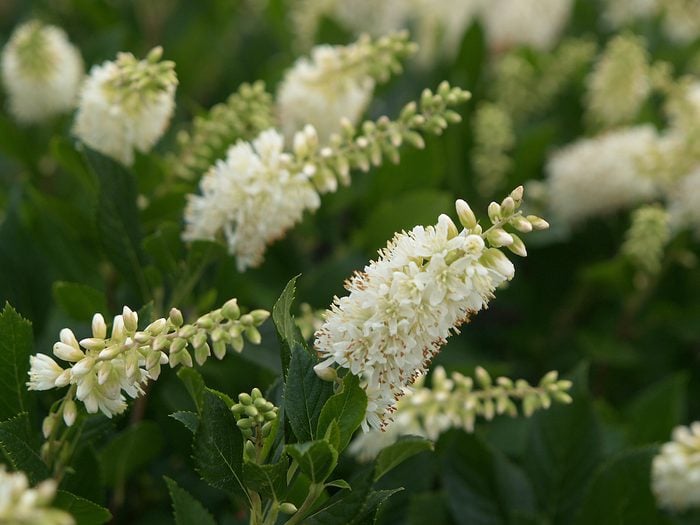
Summersweet
Clethra alnifolia, Zones 4 to 9
Attract hummingbirds, butterflies and bees with summersweet’s fragrant flowers. These white flowering shrubs are tolerant of both shade and moist soil. They will form colonies perfect for naturalizing, unless you remove the root suckers. Summersweet grows 4 to 8 feet tall and 4 to 6 feet wide. For a more compact cultivar, try Sugartina Crystalina.
Why we love it: Go ahead and plant summersweet in a shadowy spot—this is one of the few shrubs that will bloom in the shade.
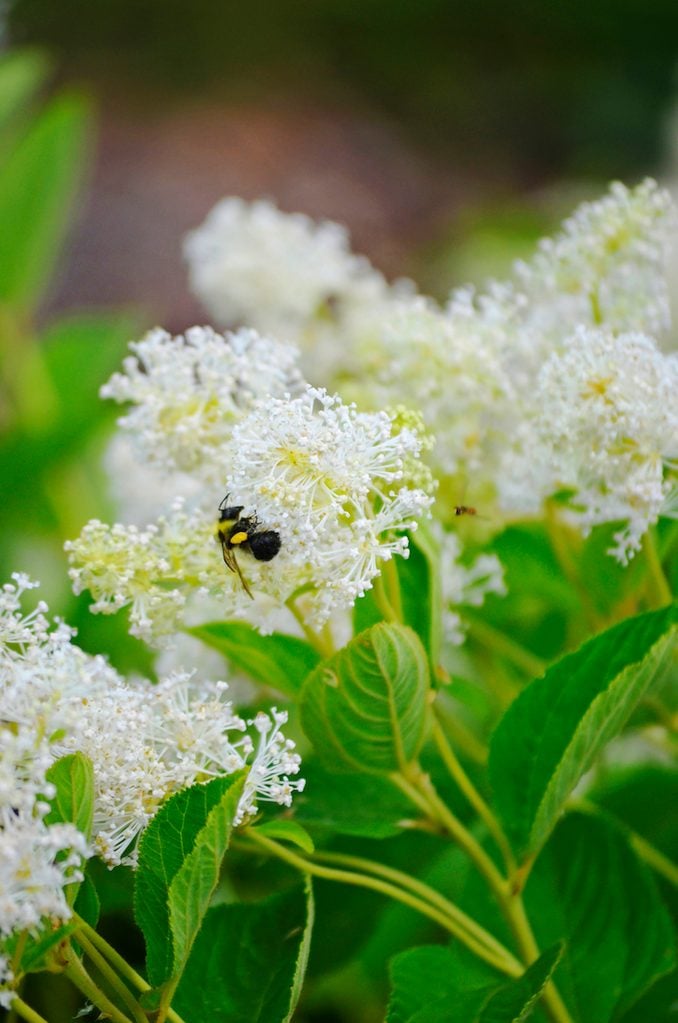
New Jersey Tea
Ceanothus americanus, Zones 3 to 8
This compact native white flowering shrub, which grows 2 to 3 feet tall and wide, attracts a wide range of pollinators, including butterflies and native bees. You may even see a few hummingbirds visit. Even better, deer tend to ignore it. New Jersey tea’s deep root system keeps it from being susceptible to many difficult-to-manage conditions.
Why we love it: Plant a group these shrubs together to create a low-growing, drought tolerant hedge.
Check out more blooming bushes that attract butterflies.
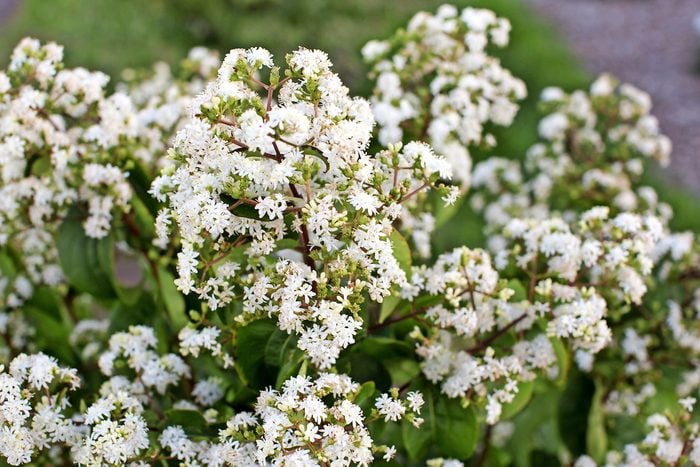
Tianshan Seven-Son Flower
Heptacodium miconioides ‘Minhep’, Zones 5 to 8
Providing year-round appeal, this is a smaller, more compact version of Heptacodium. The bark is quite beautiful, but this shrub really shines when white flowers bloom during late summer in clusters of seven—hence the number in the name.
Why we love it: Rose-purple sepals appear after the white flowers.

Silky Dogwood
Cornus amomum, Zones 4 to 8
This four-season beauty adds to any garden’s year-round charm. Look for white summer blossoms and berries that attract birds. It also looks fantastic in fall and winter. As the fiery foliage drops, it reveals brilliant red stems.
Why we love it: Deer leave silky dogwood alone and it grows well near black walnut trees.
No backyard? Plant these dwarf flowering shrubs in containers.

Chokeberry
Aronia species, Zones 3 to 9
This native shrub has it all—white spring flowers, shiny green leaves, bold red fall foliage and winter fruit. The antioxidant-rich berries will make you pucker. Even the birds leave them alone until mid- to late winter, when other food sources are scarce.
Why we love it: Newly introduced Low Scape Hedger and Low Scape Mound offer shorter, narrower options to expand design possibilities.
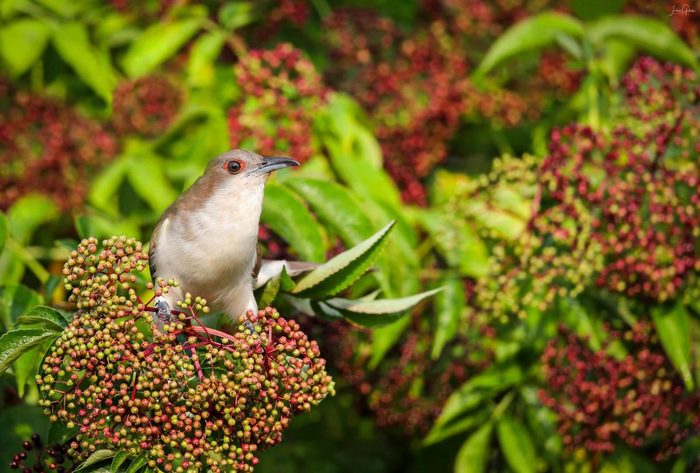
Elderberry
Sambucus nigra canadensis, Zones 3 to 9
Give this shrub plenty of room to stretch and grow; it reaches 5 to 12 feet tall and wide. Then watch as both butterflies and bees flock to the white flower clusters and birds devour the ripe fruit. Although it prefers full sun and moist soil, an elderberry shrub will tolerate drier conditions once it gets established.
Why we love it: Elderberry suckers form large and lush thickets, which are perfect hiding spots for songbirds.

Rose of Sharon
Hibiscus syriacus, Zones 5 to 8
Rose of Sharon is the hibiscus to grow if others have failed you. It reaches 8 to 12 feet tall but takes pruning well. The large flowers, which come in white, red, pink, purple and bicolors, appear from midsummer to frost. Or for an earlier show, try one of the cultivars with variegated foliage.
Why we love it: This upright shrub brings late-season color to the yard, and honeybees also love the big flowers.

Ninebark
Physocarpus opulifolius, Zones 3 to 7
The mature stems on this delightful deciduous plant peel back, or exfoliate, to expose red and light brown inner bark. Try Ginger Wine. These white flowering shrubs grow up to 6 feet tall and wide, with exceptional, orange-colored spring foliage that turns burgundy in fall. This easy to grow native plant does best in full sun and adapts to most soil types.
Why we love it: Bees and other pollinators benefit from ninebark’s long-lasting flowers. It looks best a little untidy, so no need to prune regularly.
We also adore these pink and white flowering spring-blooming trees.

Doublefile Viburnum
Viburnum plicatum tomentosum ‘Mariesii’, Zones 5 to 8
These shrubs put on a lovely display in every season. Doublefile viburnum features pretty blooms in spring and summer, attractive foliage in fall and berries in fall and winter. Just make sure you give it plenty of room to spread out, as it can grow up to 10 feet wide!
Why we love it: These white flowering shrubs have numerous benefits throughout the year. But most appealing to backyard birders are delicious red berries that many hungry fliers feast on in fall.
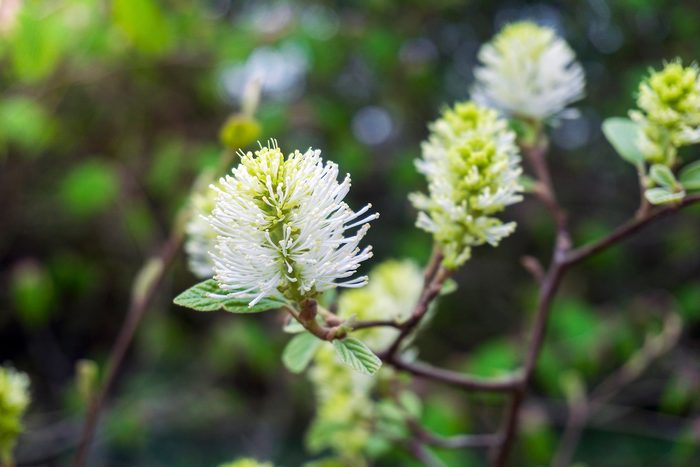
Fothergilla
Fothergilla, Zones 4 to 8
This cousin of witch hazel bursts into a kaleidoscope of color in late-autumn gardens. The brilliant yellow, orange and scarlet color combination even appears on individual leaves. Plant fothergilla in full sun to partial shade in well-draining soil. Depending on the cultivar, this shrub could grow 2 to 10 feet tall and nearly as wide.
Why we love it: These fragrant white flowering shrubs attract a crowd of pollinators before leafing out in spring.
Check out the best fall shrubs to grow.

Serviceberry
Amelanchier spp., Zones 3 to 9
Most serviceberry varieties have white flowers in early to mid-spring. In midsummer, these shrubs produce purple fruit that dozens of bird species enjoy. Bright fall foliage makes serviceberry a multi-season standout that rewards you for treating the birds.
Why we love it: The size range is broad, from small shrubs to medium-sized trees.
